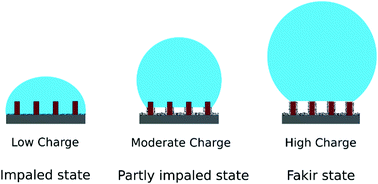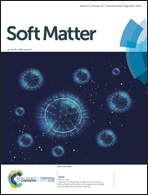Hybrid surfaces combining electropolymerization and lithography: fabrication and wetting properties
Abstract
In the current work, we developed a novel method to fabricate hybrid surfaces consisting of mixed hydrophilic/superhydrophobic properties. These surfaces specifically consist of a regular array of hydrophilic pillars (displaying a receding contact angle lower than 90°) surrounded by a superhydrophobic thinner layer made via the electropolymerization of a fluorinated monomer. Then, we determined the wetting properties of various forms of this complex surface, i.e., displaying different surface properties, by specifically determining their advancing (θa) and receding (θr) contact angles. Two main parameters were varied: the pillar density (from 21.2% to 6.5% based on using a spacing d between pillars varying from 25 to 45 micrometers) and the polymer charge density (from 0 to 100 mC cm−2). We observed that, for low charge density values, only the ground surface was covered by the hydrophobic polymers; while for higher charge density values, polymerization reached higher levels on the lateral surfaces of the nonconductive cylindrical pillars, eventually up to their top surfaces and covering them for the highest charge densities. This feature gave us an additional parameter that we could use to control the surface wettability. We also found that contact angles (advancing and receding) increased markedly with increasing polymer charge density above a critical value (which was higher for receding angles). And we measured advancing and receding contact angles to, respectively, increase and decrease with increasing pillar density. We interpreted qualitatively these behaviors, the main point being the importance of the impalement (null, partial or total).



 Please wait while we load your content...
Please wait while we load your content...